|
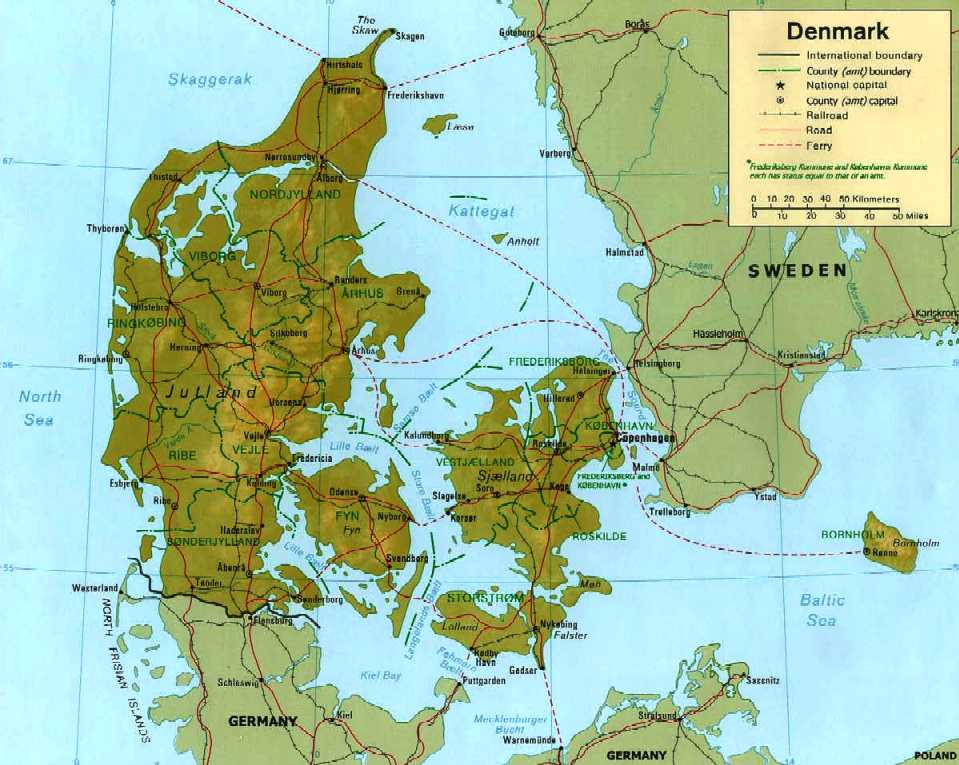
Map
of Denmark
Denmark, officially the Kingdom of Denmark, is a sovereign state in Northern
Europe, with two additional overseas constituent countries also forming integral parts of the kingdom; the Faroe Islands in the North
Atlantic and Greenland in North America. Denmark proper is the southernmost of the Nordic countries, located southwest of Sweden, with which it is connected by the Øresund Bridge, and south of Norway, and bordered to the south by Germany. The country consists of a large peninsula, Jutland, and many islands, most notably Zealand, Funen, Lolland, Falster and Bornholm, as well as hundreds of minor islands often referred to as the Danish Archipelago.
The Kingdom of Denmark is a constitutional monarchy organised in the form of a parliamentary democracy, with its seat of government in the capital city of Copenhagen. The kingdom is unitary, with powers to manage internal affairs being devolved from the central government to Greenland and the Faroe Islands; this polity is referred to as the rigsfællesskab (the Danish Realm). Denmark proper is the hegemonial area, where judicial, executive, and legislative power reside. The Faroe Islands are defined to be a community of people within the kingdom, and the Greenlandic people are defined as a separate people with the right to self-determination. One of the results of this arrangement is that Denmark became a member of the European Union in 1973, but both
Greenland and the Faroe Islands have opted to remain outside of the
EU.
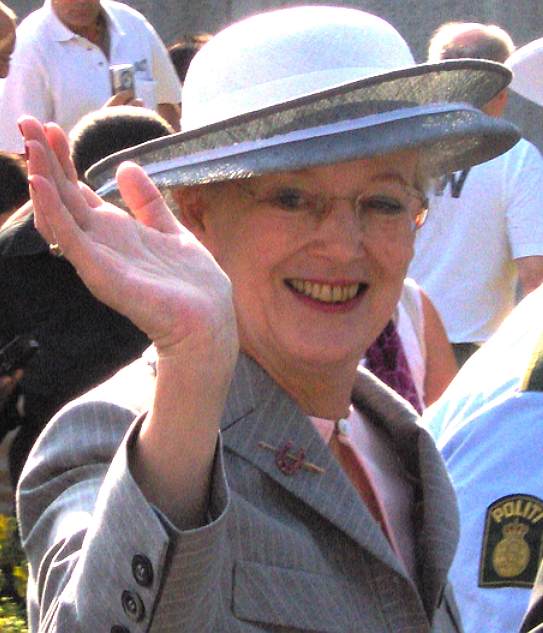
QUEEN
MARGRETHE II (Margrethe Alexandrine Þórhildur Ingrid; born 16
April 1940) is the Queen regnant of Denmark. As the eldest child of King
Frederik IX and Ingrid of Sweden, she succeeded her father upon his
death on 14 January 1972. On her accession, she became the first female
monarch of Denmark since Margrethe I, ruler of the Scandinavian
countries in 1375–1412 during the Kalmar Union. Having been on the
Danish throne for 42 years, she is currently the longest-reigning of the
three Scandinavian monarchs (Sweden's Carl XVI Gustaf has reigned since
1973 & Norway's Harald V has reigned since 1991). She is one of two
queens regnant currently on the throne along with Queen Elizabeth II.
Margrethe was born in 1940, but did not become heir presumptive until
1953, when a constitutional amendment allowed women to inherit the
throne (after it became clear that King Frederik was unlikely to have
any male issue).
Originally the home of the Vikings, Norse seafaring explorers who invaded and settled in many parts of Europe and Russia, Denmark emerged as a unified kingdom in the Middle Ages. Denmark's later history has particularly been influenced by its geographical location between the North and Baltic seas. This meant that it was between Sweden and Germany and thus at the center of the mutual struggle for control of the Baltic Sea; before the digging of the Kiel Canal, water passage to the Baltic Sea was possible only through the three channels known as the Danish straits. Denmark was long in disputes with Sweden over control of Skånelandene (Scanian War) and Norway, and in disputes with the Hanseatic League over the duchies of Schleswig (a Danish fief) and Holstein (a
German fief). Eventually Denmark lost the conflicts and ended up ceding first Skånelandene to Sweden and later Schleswig-Holstein to the German Empire. Denmark obtained Greenland and the Faroe Islands in 1814 after the dissolution of a personal union with Norway, although the Danish monarchy, which had ruled over both Norway and Denmark, had been in possession of the colonies since the fourteenth century.
A founding member of the United
Nations, NATO and the OECD, Denmark is also a member of the Organization for Security and Co-operation in Europe. With a highly developed mixed market economy and a large welfare state, Denmark ranks as having the world's highest level of income equality, and has the one of the world's highest per capita income. It has frequently ranked as the happiest and least corrupt country in the world. In 2011, Denmark was listed 16th on the
Human Development Index (8th on the inequality-adjusted HDI), 3rd on the Democracy Index and 2nd on the Corruption Perceptions Index. The national language, Danish, is closely related to Swedish and Norwegian, with which it shares strong cultural and historical ties. Denmark, along with Sweden and
Norway, is part of the cultural region known as Scandinavia and is also a member of the Nordic Council.
Capital: Copenhagen
Dialing code: 45
Currency: Danish krone
Prime minister: Helle Thorning-Schmidt
Official language: Danish Language
Government: Hereditary monarchy, Parliamentary system, Constitutional
monarchy.

Copenhagen
waterfront
GEOGRAPHY
Located in Northern Europe, Denmark consists of the peninsula of Jutland and 443 named islands (1,419 islands above 100 m² in total). Of these, 72 are inhabited, with the largest being Zealand and Funen. The island of Bornholm is located east of the rest of the country, in the
Baltic Sea. Many of the larger islands are connected by bridges; the Øresund Bridge connects Zealand with Sweden; the Great Belt Bridge connects Funen with Zealand; and the Little Belt Bridge connects Jutland with Funen. Ferries or small aircraft connect to the smaller islands. The largest cities with populations over 100,000 are the capital Copenhagen on Zealand; Århus and Aalborg in Jutland; and Odense on Funen.
Denmark occupies an area of 43,094 square kilometres (16,638.69 sq mi). The size of the land area of Denmark cannot be stated exactly since the ocean constantly erodes and adds material to the coastline, and because of human land reclamation projects (to counter erosion). It shares a border of 68 kilometres with Germany to the south and is otherwise surrounded by 7,314 km (4,545 mi) of tidal shoreline (including small bays and inlets). No location in Denmark is further from the coast than 52 km (32 mi). On the southwest coast of Jutland, the tide is between 1 and 2 m (3.28 and 6.56 ft), and the tideline moves outward and inward on a 10 km (6.2 mi) stretch.
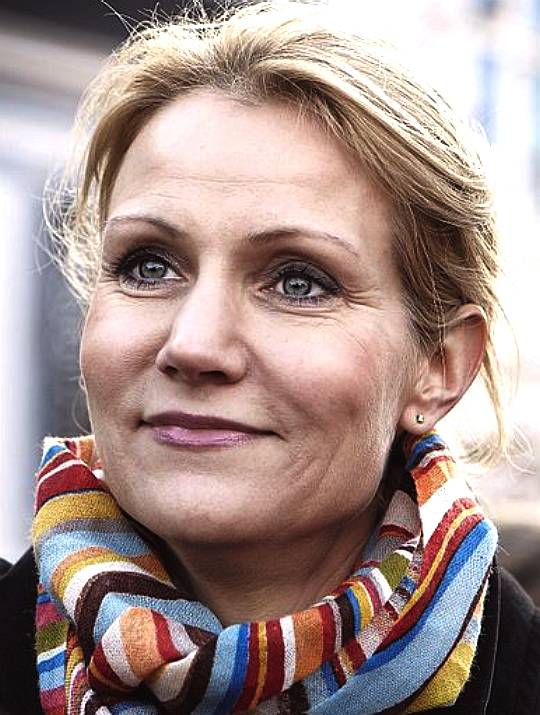
PM
- Helle Thorning-Schmidt (born 14 December 1966) is a Danish politician
who has been the Prime Minister of Denmark since 3 October 2011, and the
Leader of the Social Democrats since 12 April 2005. She is the first
woman to hold either post. Helle served as a Member of the European
Parliament for Denmark from 1999 to 2004 before being elected to the
Danish Parliament in 2005. Helle Thorning-Schmidt holds degrees in
political science from the University of Copenhagen and the College of
Europe.
Denmark's northernmost point is Skagens point (the north beach of the Skaw) at 57° 45' 7" northern latitude; the southernmost is Gedser point (the southern tip of Falster) at 54° 33' 35" northern latitude; the westernmost point is Blåvandshuk at 8° 4' 22" eastern longitude; and the easternmost point is Østerskær at 15° 11' 55" eastern longitude. This is in the archipelago Ertholmene 18 kilometres northeast of Bornholm. The distance from east to west is 452 kilometres (281 mi), from north to south 368 kilometres (229 mi).
The country is flat with little elevation; having an average height above sea level of 31 metres (102 ft). The highest natural point is Møllehøj, at 170.86 metres (560.56 ft). The area of inland water is 700 km2 (270 sq mi).
Phytogeographically, the Kingdom of Denmark (including Greenland and the Faroe Islands) belongs to the Boreal Kingdom and is shared between the Arctic, Atlantic European and Central European provinces of the Circumboreal Region. According to the World Wide Fund for Nature, the territory of Denmark can be subdivided into two ecoregions: the Atlantic mixed forests and Baltic mixed
forests. The Faroe Islands are covered by the Faroe Islands boreal grasslands, while Greenland hosts the ecoregions of Kalaallit Nunaat high arctic tundra and Kalaallit Nunaat low
arctic tundra.
CLIMATE
Denmark has a temperate climate, characterised by mild winters, with mean temperatures in January and February of 0.0 °C (32.0 °F), and cool summers, with a mean temperature in August of 15.7 °C (60.3 °F). Denmark has an average of 121 days per year with precipitation, on average receiving a total of 712 millimetres (28 in) per year; autumn is the wettest season and spring the driest.
Because of Denmark's northern location, there are large seasonal variations in daylight. There are short days during the winter with sunrise coming around 8:45 am and sunset 3:45 pm, as well as long summer days with sunrise at 4:30 am and sunset at 10 pm.
ENVIRONMENT
Denmark has historically taken a progressive stance on environmental preservation; in 1971 Denmark established a Ministry of Environment and was the first country in the world to implement an environmental law in 1973. To mitigate environmental degradation and global warming the Danish Government has signed the following international agreements: Antarctic Treaty;
Climate
Change-Kyoto Protocol; Endangered Species Act
Copenhagen is the spearhead of the bright green environmental movement in Denmark Copenhagen's most important environment research institutions are the University of Copenhagen, Copenhagen Business School, Risø DTU National Laboratory for Sustainable Energy and the Technical University of Denmark, which Risø is now part of. Leading up to the 2009 United Nations Climate Change Conference (Copenhagen Summit), the University of Copenhagen held the
Climate Change: Global Risks, Challenges and Decisions conference where the need for comprehensive action to mitigate climate change was stressed by the international scientific community. Notable figures such as Rajendra K. Pachauri, Chairman of the IPCC, Professor Nicholas Stern, author of the Stern Report and Professor Daniel Kammen all emphasised the good example set by Copenhagen and Denmark in capitalising on cleantech and achieving economic growth while stabilising carbon emissions.
Denmark's green house gas emissions per dollar of value produced has been for the most part unstable since 1990, seeing sudden growths and falls. Overall though, there has been a reduction in gas emissions per dollar value added to its market. It lags behind other Scandinavian countries such as Norway and Sweden.
ECONOMY
Denmark has a modern, prosperous and developed mixed market economy, ranking 16th in the world in terms of GDP (PPP) per capita and 5th in nominal GDP per capita. A liberalization of import tariffs in 1797 marked the end of mercantilism and further liberalization in the 19th and the beginning of the 20th century established the Danish liberal tradition in international trade that was only to be broken by the 1930s. Property rights have enjoyed strong protection. Denmark's economy stands out as one of the most free in the Index of Economic
Freedom and the Economic Freedom of the World. The economy has high levels of international trade and Denmark is known as a free trade advocate in the European Union. Denmark is one of the most competitive economies in the world according to World Economic Forum 2008 report, IMD and The Economist.
As a result of its acclaimed "flexicurity" model, Denmark has the most free labour market in Europe, according to the World Bank. Employers can hire and fire whenever they want (flexibility), and between jobs, unemployment compensation is very high (security). The
World Bank ranks Denmark as the easiest place in Europe to do business. Establishing a business can be done in a matter of hours and at very low costs. Denmark has a competitive company tax rate of 25% and a special time limited tax regime for expatriates. The Danish taxation system is broad based, with a 25% VAT, in addition to excise taxes, income taxes and other fees. The overall tax burden (sum of all taxes, as a percentage of GDP) is estimated to be 46% in 2011.
Denmark has a labour force of about 2.9 million. Denmark has the fourth highest ratio of tertiary degree holders in the world. GDP per hour worked was the 13th highest in 2009. Denmark has the world's lowest level of income inequality, according to the World Bank Gini (%), and the world's highest minimum wage, according to the
IMF. As of June 2010 the unemployment rate is at 7.4%, which is below the EU average of 9.6%.
Denmark's currency, the krone, is pegged at approximately 7.46 kroner per euro through the ERM. Although a September 2000 referendum rejected adopting the euro, the country in practice follows the policies set forth in the Economic and Monetary Union of the European Union and meets the economic convergence criteria needed to adopt the euro. The majority of the political parties in the parliament are for the euro, but as yet a new referendum has not been held, despite plans; skepticism of the EU among Danish voters has historically been strong. Denmark is known for the Danish cooperative movement within among others farming, the food industry (Danish Crown), dairy production (Arla Foods), retailing (Brugsen),
wind turbine cooperatives and co-housing associations.
Support for free trade is high – in a 2007 poll 76% responded that globalisation is a good
thing. 70% of trade flows are inside the European Union. Denmark has the 9th highest export per capita in the world. Denmark's main exports are: industrial production/manufactured goods 73.3% (of which machinery and instruments were 21.4%, and fuels, chemicals, etc. 26%); agricultural products and others for consumption 18.7% (in 2009 meat and meat products were 5.5% of total export; fish and fish products 2.9%). Denmark is a net exporter of food and
energy and has for a number of years had a balance of payments surplus while battling an equivalent of approximately 39% of GNP foreign debt or more than 300 billion DKK.
StatBank is the name of a large statistical database maintained by the central authority of statistics in Denmark. Online distribution of statistics has been a part of the dissemination strategy in Denmark since 1985. By this service, Denmark is a leading country in the world regarding electronic dissemination of statistics. There are about 2 million hits every year.
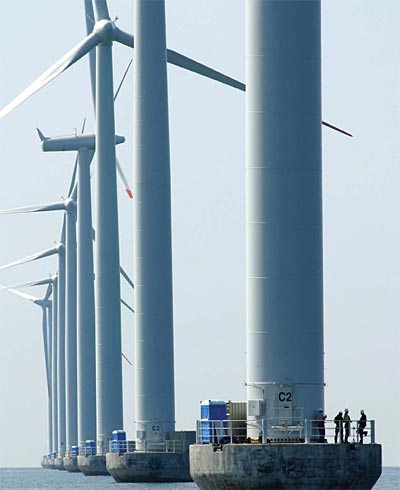
ENERGY
Denmark has considerable sources of oil and natural gas in the North Sea and ranks as number 32 in the world among net exporters of crude oil and was producing 259,980 barrels of crude
oil a day in
2009. Most electricity is produced from coal, but 25–28% of electricity demand is supplied through wind turbines. Denmark is a long time leader in wind energy, and as of May 2011 Denmark derives 3.1% of its gross domestic product from renewable (clean) energy technology and
energy efficiency, or around €6.5 billion ($9.4 billion). Denmark is connected by electric transmission lines to other European countries. On 6 September 2012, Denmark launched the biggest
wind turbine in the world, and adding four more the next four years.
Denmark's electricity sector has integrated fluctuating and unpredictable energy sources such as wind power into the national grid. Denmark now aims to focus on intelligent battery systems (V2G) and plug-in vehicles in the transport sector.
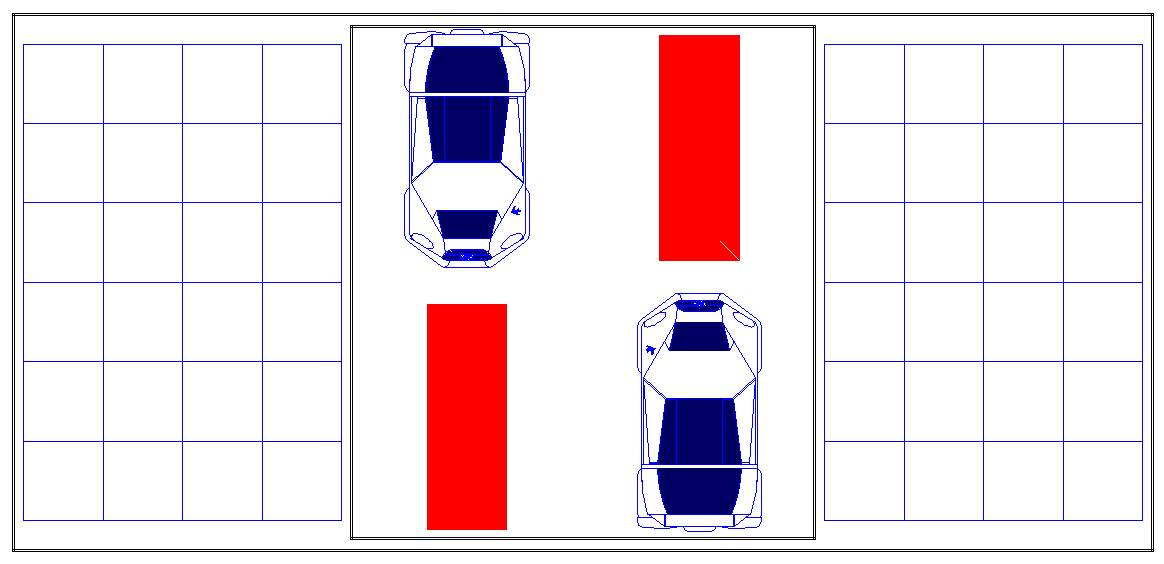
EURO-STATION
plan and end elevations

|
SMART
CITY EURO-STATION - The Ecostar
DC50 city sports car is shown here to scale alongside a universal Bluebird™ energy
cartridge (in red)
of the form suitable for most super-mini city cars of today.
The Ecostar is a very small and low sports car. Whereas, the service
station is designed to accommodate large vans. These drawings are to
give you some idea of the size of the plot of land that is needed in a
city. The example service station is shown here with solar panels on the
roof. There would be nothing to stop an operator from having other
buildings and land with more solar panels to harvest renewable energy.
In addition, a service station like this is a load-leveling device for
power generating stations that are on tickover between peaks. You might
ask why then, that there are currently no utilities looking at this
project? The reason is that coal
is much cheaper for them to burn, regardless of climate change - and
there is nothing to stop them doing so. Because, 2030 Euro targets are
not binding on member states. Check out the report by Business
Monitor International. Note also, that it makes no difference which
way around a vehicle enters the service tunnel. That is because a
Bluebird™ energy cartridge may be loaded either way - and still
connect electrically correctly. The design of the Eurostation is ©
copyright Bluebird Marine Systems Ltd. The system' workings are soon to
be patent applied
for - which is why we cannot show how we achieve a low-cost utility with
only 28 moving parts. Investors
and development partners are invited.
TRANSPORT
Significant investment has been made in building road and rail links between regions in Denmark, most notably the Great Belt Fixed Link, which connects Zealand and Funen. It is now possible to drive from Frederikshavn in northern Jutland to Copenhagen on eastern Zealand without leaving the motorway. The main railway operator is DSB for passenger services and DB Schenker Rail for freight trains. The railway tracks are maintained by Banedanmark. Copenhagen has a small Metro system, the Copenhagen Metro, and the Greater Copenhagen area has an extensive electrified suburban railway network, the S-train. Denmark's national airline (together with Norway and Sweden) is Scandinavian Airlines (SAS), and Copenhagen Airport is the largest in Scandinavia. A ferry link to the Faroe Islands is maintained by Smyril Line. Other international ferry services are mainly operated by DFDS (to Norway and the UK), Scandlines (to Germany and Sweden), Stena Line (to Norway, Sweden, and Poland), Color Line (to Norway), and FjordLine (to Norway).
Private vehicles are increasingly used as a means of transport. Because of the high registration tax (180%), VAT (25%), and one of the world's highest income tax rates, new cars are very expensive. The purpose of the tax is to discourage car ownership. The car fleet has increased by 45% over the last 30 years. In 2007 an attempt was made by the government to favor environmentally friendly cars by slightly reducing taxes on high mileage vehicles. However, this has had little effect, and in 2008 Denmark experienced an increase in the import of fuel inefficient old
cars primarily from Germany, as the cost for older cars - including taxes
- keeps them within the budget of many Danes. The average car age (year 2011) is 9.2 years.
Bicycling in Denmark is a common form of transportation, particularly for the young and for city dwellers. With a network of bicycle routes extending more than 12,000
km and an estimated 7,000 km of segregated dedicated bicycle paths and lanes, Denmark has a solid bicycle infrastructure.

NAVIGATION
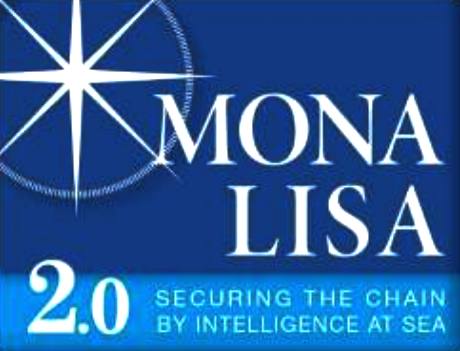
MONA
LISA 2
MonaLisa 2 is a Swedish led project concentrating on Sea Traffic Management with
increased focus on the safe navigation of
large passenger vessels, after the Costa
Concordia and Baltic
Ace accidents in
January and December 2012. MonaLisa 2 is a continuation of the MonaLisa 1
project, the partners for which are as follows:-
The Danish
Maritime Authority has
responsibility for the construction, equipment and operation of Danish
ships including safety, navigational regulations, ship registration,
shipping policy, maritime law as well as industrial policy, both
nationally and internationally. The DMA is a government agency part
of the Ministry of Business.
The Finnish
Transport Agency The
Finnish Transport Agency is responsible for the traffic management on
roads, waterways and railways. The Finnish Transport Agency’s
Hydrographic Office publishes printed and electronic charts of Finland’s
coastal and lake areas and manages the ongoing chart update service.
GateHouse is
specialises in the development of technical software and system
integration for advanced satellite communications and tracking systems.
They are a leading independent provider of complete embedded software for Inmarsat BGAN
terminals
SAAB serves
the global market: governments (navy), coastguards and corporations with
products, services and solutions from military defence to civil navigation
via LPI pulsed radar, sonar and
other transponders.
SSPA provide
effective marine transport solutions for the maritime field – ship
design, maritime operations, port development and coastal services.
Seventy percent of the earth’s surface
is water, with 90 percent of cargo transported by ships. SSPA is aware
that the maritime industry has tremendous impact on our environment.
The Swedish
Maritime Administration (SMA)
offers modern and safe shipping routes with 24 hour service. SMA is a
governmental agency and enterprise within the transport sector and is
responsible for maritime safety and the future of shipping, primarily
merchant shipping, but also pleasure boating and fishing. Services
include: Port Pilots and Marine Traffic Information
The University
of Chalmers is a
highly progressive, situated in Gothenburg. They are known globally for
education, research and innovation.
EfficienSea is
concerned with the development of safe sustainable traffic at sea - in
particular the e-Navigation: "the harmonized creation,
collection, integration, exchange and presentation of maritime information
on board and ashore by electronic means to enhance berth-to-berth
navigation and related services, for safety and security at sea and
protection of the marine environment." Ref: Committee of the
International Association of Marine Aids to Navigation and Lighthouse
Authorities, IALA.
MONA LISA CONTACTS
Magnus
Sundström
MONALISA Project Leader
Swedish
Maritime Administration
Market Department
Phone: +46 10 47 84 681
E-mail: magnus.sundstrom@sjofartsverket.se
http://www.sjofartsverket.se/en/MonaLisa/
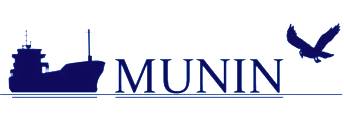
MUNIN
The
MUNIN project (Maritime Unmanned Navigation through Intelligence in
Networks) is a collaborative research project, co-funded by the European
Commission under its
Seventh Framework Programme.
The MUNIN project is to develop and verify a concept for an autonomous ship, which they define as a vessel primarily guided by automated on-board decision system. The onboard system is finally controlled by a remote operator in a shore side control station. The concept therefore runs parallel to the thinking of the SolarNavigator team - provided only that the levels of autonomy may vary - clearly, a solar powered ship is that much more self
reliant.
MUNIN
PARTNERS
The
Fraunhofer Center for Maritime Logistics and Services CML (Fraunhofer CML)
is situated at the Hamburg University of Technology in Hamburg, Germany. Fraunhofer
CML homepage Hans-Christoph
Burmeister, is the project coordinator at Fraunhofer CML
The
Norwegian Marine Technology Research Institute (MARINTEK), Trondheim,
Norway. MARINTEK is a company in the SINTEF Group, one of Europe’s
largest independent research institutions. MARINTEK
homepage
Chalmers
University of Technology is a Swedish university
located in Gothenburg that focuses on research and education in
technology, natural science, and architecture. Chalmers
homepage
Hochschule
Wismar – University of Applied Sciences Technology: Department of
Maritime Studies is part of the faculty of Engineering at Hochschule
Wismar, situated in Rostock-Warnemünde, Germany. They are exerts in
simulator training as full mission ship handling carried out by Professors
and lecturers with license management levels such as Master of a ship or
Chief Engine Officer. Hochschule
Wismar homepage
Aptomar
AS is a Norwegian company located in Trondheim specialising in marine
sensor systems such as the SECurus system that combines advanced
stabilized long range IR and digital video cameras with an Electronic
Chart System which overlays information of several sources for a speedy
evaluation of real time situations for good response. Aptomar
AS homepage
MarineSoft
Entwicklungs- und Logistikgesellschaft mbH is an internationally operating
provider for maritime software solutions, located in Rostock-Warnemünde,
Germany. It offers state-of-the-art solutions in the field of maritime
simulation of machinery plants, computer based training applications,
information and operation systems, consultancy and courseware. MarineSoft
homepage
Marorka
ehf is a leading provider of energy management solutions for the
international shipping industry with it’s headquarters in Reykjavik, Iceland.
Marorka’s products and services enable vessel operators to optimize fuel
consumption by maximizing the energy efficiency of their vessel or fleet. Marorka
ehf homepage
University
College Cork UCC is situated in south-west Ireland and
was founded as a Queen’s College in 1845. The Law Department at UCC is
at the forefront of legal research in Ireland, the EU and internationally
in various areas, including environmental law, human rights, marine
law,
business law, comparative law, constitutional law and legal theory. UCC
homepage
MUNIN
CONTACTS
Project
Manager - Hans-Christoph
Burmeister
Fraunhofer
Center for Maritime Logistics and Services CML
Schwarzenbergstraße 95 D
21073 Hamburg, Germany
Phone: +49 (0)40 42878-6131
Fax: +49 (0)40 42878-4452
Ørnulf
Jan Rødseth
MARINTEK
Dep. Maritime Transport Systems
Otto Nielsens veg 10
Trondheim, Norway
Phone: +47 7359 5257
info@unmanned-ship.org
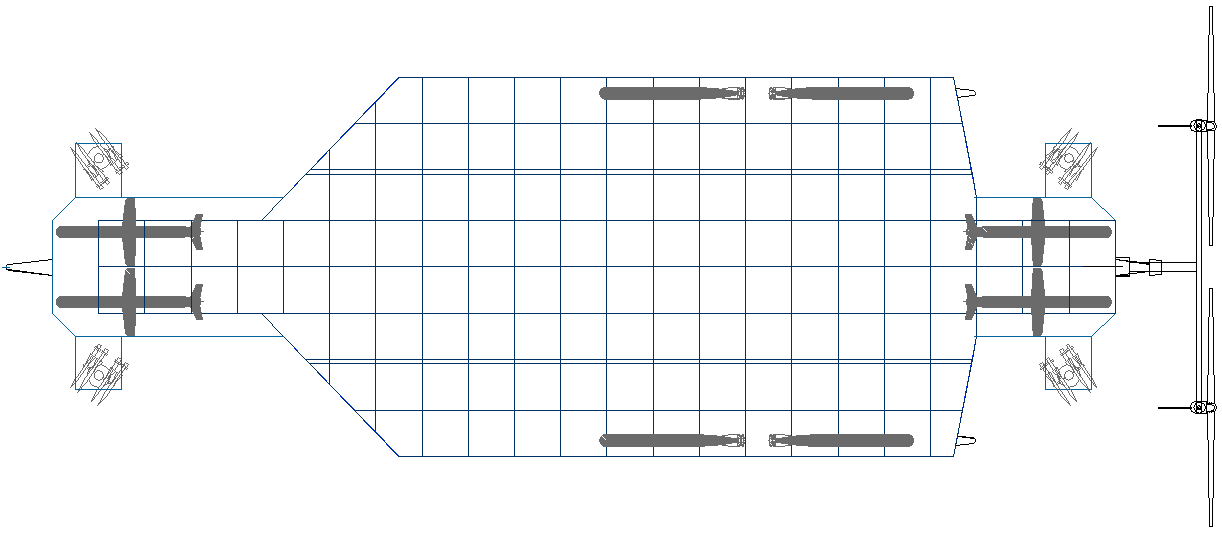
DRONE
MICRO BATTLESHIP - A
Scorpion HK - fitted with 4 x SAM turrets (one per corner), for 360
degree independent cover. Each SAM turret carries 8 missiles (Rapier
example), giving a battery of 32 rockets to fend off enemy aircraft. The
micro battleship is also shown here with 4 Tomahawk cruise
missiles in protected bays, fore and aft, and 4 x 21"
MK48 torpedoes
in the outriggers - all drawn to scale - as a prelude to proof of
concept. The torpedoes and cruise missiles would not be visible, but
we've shown them as though the drawing were an x-ray. The OAL of this
genius design is 52.7m or 171 feet. She can cruise all day and night at
7-10 knots and sprint up to 25knots, depending on specification.
This
original concept vessel is design copyright © BMS Ltd 2014. The
technology is also patent
applied for. Being an unmanned drone, there is no need for crew
quarters, provisions or other life support. What is essential is a
robust onboard navigation system that is artificially intelligent.
Another essential, is encrypted satellite communications, such that
firing of missiles is sanctioned by a human operator. If fired upon, the
robot ship will return fire in self-defence mode. RoboShip is about to
come of age.
The
battleship also carries a ROV
that may be deployed from the mothership remotely, with other sensors to
locate and clear mines.
In tandem with military surveillance duties, the ship can sample and map
the oceans all at the same time. That could save any navy a pretty penny
- not to mention - that this vehicle is powered by energy from nature.
So, no nuclear
waste and no diesel
smog = environmental peacekeeping.
TECHNOLOGY
In the 20th century, Danes have also been innovative in several fields of the technology sector. Danish companies have been influential in the shipping industry with the design of the largest and most energy efficient container ships in the world, and Danish engineers have contributed to the design of MAN
Diesel engines. In the software and electronic field, Denmark contributed to design and manufacturing of Nordic Mobile Telephones, and the now-defunct Danish company DanCall was among the first to develop GSM mobile phones.
Danish engineers are world-leading in providing diabetes care equipment and medication products from Novo Nordisk and, since 2000, the Danish biotech company Novozymes, the world market leader in enzymes for first generation starch based bioethanol, has pioneered development of enzymes for converting waste to cellulosic ethanol. Medicon Valley, spanning the Øresund Region between Zealand and Sweden, is one of Europe's largest life science clusters, containing a large number of life science companies and research institutions located within a very small geographical area. Danish software engineers have taken leading roles in some of the world's important programming languages: Anders Hejlsberg, (Turbo Pascal, Delphi, C#); Rasmus Lerdorf, (PHP); Bjarne Stroustrup, (C++); David Heinemeier Hansson, (Ruby on Rails); Lars Bak pioneer in virtual machines, (V8, Java VM, Dart).
DEMOGRAPHICS
According to 2012 figures from Statistics Denmark, 89.6% of Denmark's population of over 5,580,516 is of Danish descent.[109] Many of the remaining 10.4% are immigrants—or descendants of recent immigrants—from neighbour countries, Turkey, Iraq, Somalia, Bosnia and Herzegovina, South Asia and the Middle East. Of the 10.4%, approximately 200,000 (34%) are of a Western background, and approx. 390,000 (66%) have a non-Western background.
The median age is 39.8 years, with 0.98 males per female. 98.2% of the population (age 15 and up) is literate. The birth rate is 1.74 children born per woman (2006 est.). Despite the low birth rate, the population is still growing at an average annual rate of
0.33%. An international study conducted by Adrian White at Leicester University in 2006 showed that the population of Denmark had the highest life satisfaction in the world.
Danish, Faroese, and Greenlandic are the official languages of mainland Denmark, the Faroes, and Greenland, respectively; German is an official minority language in the former South Jutland County near the German border. Danish is spoken throughout the kingdom and is the national language of Denmark. English and German are the most widely spoken foreign languages.
EDUCATION
The Danish education system provides access to primary school, secondary school and higher education. All college and university education in Denmark are free of charges; there are no tuition fees to enroll in courses. Students in secondary school or higher and aged 18 or above may apply for student support which provides fixed financial support, disbursed monthly. As of 2012 it is approximately 6000 DKR or $1000 pr. month. The Education Index, published with the UN's Human Development Index in 2008, based on data from 2006, lists Denmark as 0.993, amongst the highest in the world, tied for first with
Australia,
Canada, Finland and New Zealand.
Primary school in Denmark is called "Public School" (Folkeskole). Attendance at primary school is compulsory for a minimum of 10 years, from the age of 6 to 16. Pupils can alternatively attend "free schools" (Friskole), or private schools (Privatskole) – schools that are not under the administration of the municipalities, such as Christian schools or Waldorf
schools.
Following graduation from Public School, there are several other educational opportunities, including Gymnasium (academically oriented upper secondary education), Higher Preparatory Examination (HF) (similar to Gymnasium, but one year shorter), Higher Technical Examination Programme (HTX) (with focus on mathematics and engineering), and Higher Commercial Examination Programme (with a focus on trade and business), as well as vocational education, training young people for work in specific trades by a combination of teaching and apprenticeship.
Danish universities and other higher education institutions offer international students a range of opportunities for obtaining an internationally recognised qualification in Denmark. Many programmes are taught in English, including Bachelor's, Master's, PhD, exchange and summer school programmes.
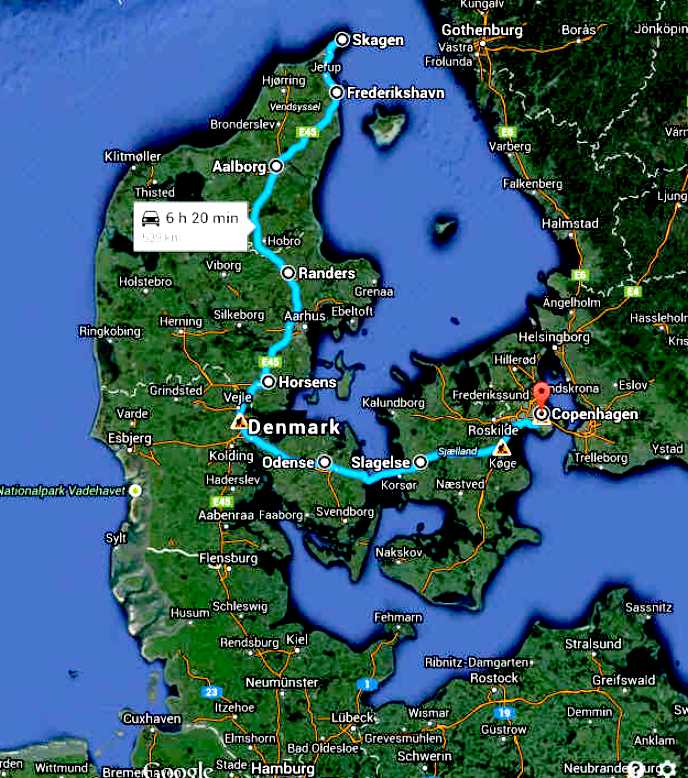
ROUTE
MAP DANISH CANNONBALL RUN - The Cannonball
International EV Run™ series is for battery or hydrogen fuel
cell powered electric vehicles that are based on ordinary production
vehicle running gear and must be capable of carrying at least one
passenger. They may be solar assisted, provided that the solar panel
area does not exceed four square meters - a rule that may be relaxed in
subsequent years as we learn from experience. See the full
Cannonball EV rules HERE.
These rules are designed to promote the development of an international
EV infrastructure,
as a means of accelerating the transition from IC
engines to clean electric motors, especially in countries that do not
have abundant sunshine, where support for non-solar assisted
electric vehicles is all the more important.
SKAGEN
to COPENHAGEN: THE DANISH CANNONBALL ZEV RUN SUGGESTED STOPS @
50mph AVE
|
START
|
SKAGEN
|
MILES
RUN
|
LEG
DISTANCE
|
KM
RUN
|
HOURS
|
|
|
|
|
40.9
|
|
|
|
1st
STOP
|
FREDERIKSHAVN
|
25.42
|
+
|
40.9
|
.51
|
|
|
|
|
63.9
|
|
|
|
2nd
STOP
|
AALBORG
|
65.12
|
+
|
104.8
|
1.30
|
|
|
|
|
80.2
|
|
|
|
3rd
STOP
|
RANDERS
|
114.95
|
+
|
185.0
|
2.30
|
|
|
|
|
81.1
|
|
|
|
4th
STOP
|
HORSENS
|
165.5
|
+
|
266.1
|
3.31
|
|
|
|
|
102
|
|
|
|
5th
STOP
|
ODENSE
|
228.73
|
+
|
368.1
|
4.58
|
|
|
|
|
71.6
|
|
|
|
6th
STOP
|
SLAGELSE
|
273.22
|
+
|
439.7
|
4.75
|
|
|
|
|
98.2
|
|
|
|
FINISH
|
COPENHAGEN
|
334.24
|
|
537.9
|
6.69
|
OTHER
OFFICIAL CANNONBALL INTERNATIONAL ROUTES
PUBLIC POLICY
After deregulating the labour market in the 1990s, Denmark has one of the most free labour markets in European countries. According to World Bank labour market rankings, the labour market flexibility is at the same levels as the United States. Around 80% of employees belong to unions and the unemployment funds that are attached to them. Labour market policies are mainly determined in negotiations between the workers' unions and employers' unions, and the government only interferes if labour strikes extend for too long.
Despite the success of the trade unions, a growing number of people make contracts individually rather than collectively, and many (four out of ten employees) are contemplating dropping especially unemployment fund but occasionally even union membership altogether. The average employee receives a benefit at 47% of their wage level if they have to claim benefits when unemployed. With low unemployment, very few expect to be claiming benefits at all. The only reason then to pay the earmarked money to the unemployment fund would be to retire early and receive early retirement pay (efterløn), which is possible from the age of 60 provided an additional earmarked contribution is paid to the unemployment fund.
The unemployment rate for December 2007 was 2.7%, for a total of 74,900 persons, a reduction by 112,800 persons
- 2,400 per month - or 60% since December 2003. The Eurostat unemployment number for August 2008 is 2.9%. Another measure of the situation on the labour market is the employment rate, that is the percentage of people aged 15 to 64 in employment out of the total number of people aged 15 to 64. The employment rate for Denmark in 2007 was 77.1% according to Eurostat. Of all countries in the world, only
Switzerland with 78.% and Iceland with 85.1% had a higher employment rate. Of the employed more than 38% (800,000 people) of the total workforce work in public sector jobs.
The number of unemployed is forecast to be 65,000 in 2015. The number of people in the working age group, less disability pensioners etc., will grow by 10,000 to 2,860,000, and jobs by 70,000 to 2,790,000; part-time jobs are included. Because of the present high demand and short supply of skilled labour, for instance for factory and service jobs, including hospital nurses and physicians, the annual average working hours have risen, especially compared with the recession 1987–1993. Increasingly, service workers of all kinds are in demand, i.e. in the postal services and as bus drivers, and academics. In the fall of 2007, more than 250,000 foreigners are working in the country, of which 23,000 still reside in Germany or Sweden. According to a sampling survey of over 14,000 enterprises from December 2007 to April 2008 39,000 jobs were not filled, a number much lower than earlier surveys, confirming a downturn in the
economic cycle.
The level of unemployment benefits is dependent on former employment (the maximum benefit is at 90% of the wage) and at times also on membership of an unemployment fund, which is almost always
- but need not be - administered by a trade union, and the previous payment of contributions. However, the largest share of the financing is still carried by the central government and is financed by general taxation, and only to a minor degree from earmarked contributions. There is no taxation, however, on proceeds gained from selling one´s home (provided there was any home equity (friværdi)), as the marginal tax rate on capital income from housing savings is around 0%. In 2011, 13.4% of Denmark's population was reported to live below the poverty line.
Denmark follows the Nordic model of a mixed economy, characterised by a large welfare state, a high level of public expenditure and a universal social system (including health care), financed by taxes and not by social contributions. The welfare model is accompanied by a taxation system that is both broad based (25% VAT, not including excise, duty and tax) and with a progressive income tax model, meaning the more money that is earned, the higher income tax percentage that gets paid (minimum tax rate for adults is 42% scaling to over 60%, except for the residents of Ertholmene that escape the otherwise ubiquitous 8% healthcare tax fraction of the income taxes). Other taxes include the registration tax on private vehicles, at a rate of 180%, on top of VAT. Lately (July 2007) this has been changed slightly in an attempt to favor more fuel efficient cars but maintaining the average taxation level more or less unchanged.
CULTURE
Historically, Denmark, like its Scandinavian neighbors, has been one of the most socially progressive cultures in the world. For example, in 1969, Denmark was the first country to legalise pornography, and in 2012, Denmark replaced its "registered partnership" laws, which it had been the first country to introduce in 1989, with gender-neutral marriage. Modesty, punctuality but above all equality are important aspects of the Danish way of life.
The astronomical discoveries of Tycho Brahe (1546–1601), Ludwig A. Colding's (1815–1888) neglected articulation of the principle of conservation of energy, and the brilliant contributions to atomic physics of Niels Bohr (1885–1962) indicate the range of Danish scientific achievement. The fairy tales of Hans Christian Andersen (1805–1875), the philosophical essays of Søren Kierkegaard (1813–1855), the short stories of Karen Blixen (penname Isak Dinesen), (1885–1962), the plays of Ludvig Holberg (1684–1754), and the dense, aphoristic poetry of Piet Hein (1905–1996), have earned international recognition, as have the symphonies of Carl Nielsen (1865–1931). From the mid 1990s, Danish films have attracted international attention, especially those associated with Dogme 95 like those of Lars Von Trier.
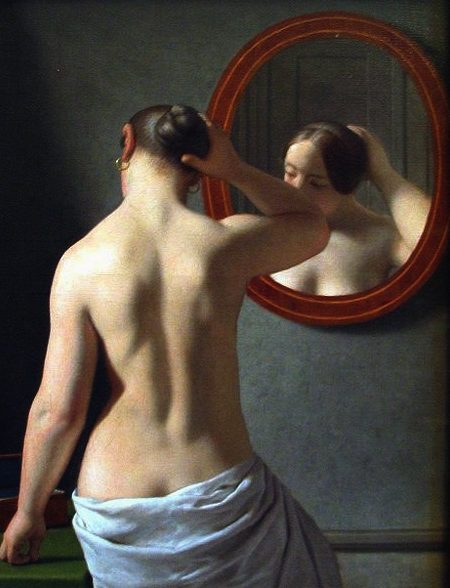
PAINTING
& PHOTOGRAPHY
While Danish art was influenced over the centuries by trends in Germany and the Netherlands, the 15th and 16th century church frescos which can be seen in many of the country's older churches are of particular interest as they were painted in a style typical of native Danish painters.
The Danish Golden Age, which began in the first half of the 19th century, was inspired by a new feeling of nationalism and romanticism. Christoffer Wilhelm Eckersberg was not only a productive artist in his own right but taught at the Royal Danish Academy of Fine Arts where his students included notable painters such as Wilhelm Bendz, Christen Købke, Martinus Rørbye, Constantin Hansen, and Wilhelm Marstrand. The sculpture of Bertel Thorvaldsen was also significant during this period.
In 1871, Holger Drachmann and Karl Madsen visited Skagen in the far north of Jutland where they quickly built up one of Scandinavia's most successful artists' colonies specializing in Naturalism and Realism rather than in the traditional approach favored by the Academy. Hosted by Michael and his wife Anna, they were soon joined by P.S. Krøyer, Carl Locher and Laurits Tuxen. All participated in painting the natural surroundings and local people. Similar trends developed on Funen with the Fynboerne who included Johannes Larsen, Fritz Syberg and Peter Hansen, and on the island of Bornholm with the Bornholm school of painters including Niels Lergaard, Kræsten Iversen and Oluf Høst.
Danish photography has developed from strong participation and interest in the very beginnings of the art in 1839 to the success of a considerable number of Danes in the world of photography today. Pioneers such as Mads Alstrup and Georg Emil Hansen paved the way for a rapidly growing profession during the last half of the 19th century while both artistic and press photographers made internationally recognised contributions. Today Danish photographers such as Astrid Kruse Jensen and Jacob Aue Sobol are active both at home and abroad, participating in key exhibitions around the world.
Collections of modern art enjoy unusually attractive settings at the Louisiana Museum of Modern Art north of Copenhagen and at the North Jutland Art Museum in Aalborg. Notable artists include the Neo-Expressionist Per Kirkeby, Tal R with his wild and colorful paintings, Olafur Eliasson's space exhibitions and Jeppe Hein's installations.
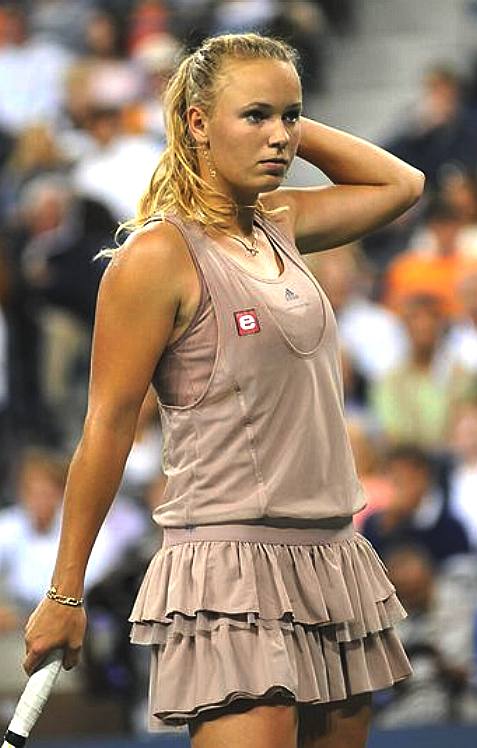
SPORT
Sports are popular in Denmark, and its citizens participate in and watch a wide variety. The national sport is football (soccer). Denmark qualified six times in a row between 1984 and 2004 for the European Championships, and won the Championship in 1992. Other significant achievements include winning the Confederations Cup in 1995 and reaching the quarter-final of the 1998 World Championships. Notable Danish footballers include Peter Schmeichel, named the "World's Best Goalkeeper" in 1992 and 1993, and Michael Laudrup, named the best Danish player of all time by the Danish Football Association.
In recent years, Denmark has made a mark as a strong cycling nation, with Bjarne Riis winning
Tour de France in 1996 and Michael Rasmussen reaching King of the Mountains status in the Tour in 2005 and 2006. In speedway racing Denmark has won several world championships, including the Speedway World Cup in 2006 and 2008.
Other popular sports include golf - which is mostly popular among those in the older demographic; tennis
- in which Denmark is successful on a professional level; rugby - the Danish
Rugby Union dates back to 1950; rowing -
Denmark specialize in light-weight rowing and are particularly known for their light-weight coxless four, having won six gold and two
silver World Championship medals and three
gold and two bronze Olympic medals; and several indoor sports
- especially badminton, handball, table tennis and gymnastics, in each of which Denmark holds World Championships and Olympic medals. Denmark's numerous beaches and resorts are popular locations for
fishing, canoeing, kayaking, and many other water-themed sports.
As of January 2012, the national handball team are the current reigning European champions. On the men's side, they have won five medals
- two gold (in 2008 and 2012) and three bronze (in 2002, 2004 and 2006) -
the most that have been won by any team in European Championship history.
PRE HISTORY
The earliest archaeological findings in Denmark date back to the Eem interglacial period from 130,000–110,000 BC. Denmark has been inhabited since around 12,500 BC and agriculture has been evident since 3900
BC. The Nordic Bronze Age (1800–600 BC) in Denmark was marked by burial mounds, which left an abundance of findings including lurs and the Sun Chariot.
During the Pre-Roman Iron Age (500 BC – 1 AD), native groups began migrating south, although the first Danish people came to the country between the Pre-Roman and the Germanic
Iron Age, in the Roman Iron Age (1–400 AD). The Roman provinces maintained trade routes and relations with native tribes in Denmark, and Roman coins have been found in Denmark. Evidence of strong Celtic cultural influence dates from this period in Denmark and much of North-West Europe and is among other things reflected in the finding of the Gundestrup cauldron.
Historians believe that before the arrival of the precursors to the Danes, who came from the east Danish islands (Zealand) and Skåne and spoke an early form of North Germanic, most of Jutland and the nearest islands were settled by Jutes. They were later invited to Great Britain as mercenaries by Brythonic King Vortigern and were granted the southeastern territories of Kent, the Isle of Wight among other areas, where they settled. They were later absorbed or ethnically cleansed by the invading Angles and Saxons, who formed the Anglo-Saxons. The remaining population in Jutland assimilated in with the Danes.
A short note about the Dani in "Getica" by historian Jordanes is believed by some to be an early mention of the Danes, one of the ethnic groups from whom the modern Danish people are descended. The Danevirke defence structures were built in phases from the 3rd century forward, and the sheer size of the construction efforts in 737 are attributed to the emergence of a Danish king. The new runic alphabet was first used around the same time, and Ribe, the oldest town of Denmark, was founded about 700.
MIDDLE AGES
From the 8th to the 10th century, the Danes were known as Vikings. Together with Norwegians and Swedes, they colonised, raided and traded in all parts of Europe. Viking explorers first discovered Iceland by accident in the 9th century, on the way towards the Faroe Islands and eventually came across "Vinland" (Land of wine) also known today as Newfoundland, in Canada. The Danish Vikings were most active in the British Isles and Western Europe. They temporarily conquered and settled parts of England (known as the Danelaw), Ireland and France where they founded Normandy. More Anglo-Saxon pence of this period have been found in Denmark than in England. As attested by the Jelling stones, the Danes were united and Christianised about 965 by Harald Bluetooth. It is believed that Denmark became
Christian for political reasons so as not to get invaded by the rising Christian power in Europe, Germania, which was an important trading area for the Danes. In that case Harald built six fortresses around Denmark called Trelleborg and built a further Danevirke. In the early 11th century Canute the Great won and united Denmark, England and Norway for almost 30 years.
Throughout the High and Late Middle Ages, Denmark also included Skåneland (Skåne, Halland and Blekinge) and Danish kings ruled Danish Estonia, as well as the duchies of Schleswig and Holstein. Most of the latter two now form the state of Schleswig-Holstein in northern Germany.
In 1397, Denmark entered into a personal union with Norway and Sweden, united under Queen Margaret I. The three countries were to be treated as equals in the union. However, even from the start Margaret may not have been so idealistic
- treating Denmark as the clear "senior" partner of the union. Thus, much of the next 125 years of Scandinavian history revolves around this union, with Sweden breaking off and being re-conquered repeatedly. The issue was for practical purposes resolved on 17 June 1523, as Swedish King Gustav Vasa conquered the city of Stockholm.
The Protestant Reformation came to Scandinavia in the 1530s, and following the Count's Feud civil war, Denmark converted to Lutheranism in 1536. Later that year, Denmark entered into a union with Norway.
EARLY MODERN HISTORY
After Sweden permanently broke away from the Kalmar Union in 1523, Denmark tried on two occasions to reassert control over Sweden. The first was in the Northern Seven Years War which lasted from 1563 until 1570. The second occasion was the Kalmar War when King Christian IV attacked Sweden in 1611 but failed to accomplish his main objective of forcing Sweden to return to the union with Denmark. The war led to no territorial changes, but Sweden was forced to pay a war indemnity of 1 million silver riksdaler to Denmark, an amount known as the Älvsborg ransom.
King Christian used this money to found several towns and fortresses, most notably Glückstadt (founded as a rival to Hamburg), Christiania (following a fire destroying the original city of Oslo), Christianshavn, Christianstad and Christiansand. Christian also constructed a number of buildings, most notably Børsen, Rundetårn, Nyboder, Rosenborg, a silver mine and a copper mill. Inspired by the Dutch East India Company, he founded a similar Danish company and planned to claim Ceylon as a colony, but the company only managed to acquire Tranquebar on
India's Coromandel Coast. Denmark's large colonial aspirations were limited to a few key trading posts in Africa and India.
In the Thirty Years' War, Christian tried to become the leader of the Lutheran states in Germany but suffered a crushing defeat at the Battle of
Lutter. The result was that the Catholic army under Albrecht von Wallenstein was able to invade, occupy and pillage Jutland, forcing Denmark to withdraw from the war. Denmark managed to avoid territorial concessions, but Gustavus Adolphus' intervention in Germany was seen as a sign that the military power of Sweden was on the rise while Denmark's influence in the region was declining. Swedish armies invaded Jutland in 1643 and claimed Skåne in 1644. According to Geoffrey Parker, "The Swedish occupation caused a drop in agricultural production and a shortage of capital; harvest failure and plague ravaged the land between 1647 and 1651; Denmark's population fell by 20 per cent."
In the 1645 Treaty of Brømsebro, Denmark surrendered Halland, Gotland, the last parts of Danish Estonia, and several provinces in Norway. In 1657, king Frederick III declared war on Sweden and marched on Bremen-Verden. This led to a massive Danish defeat and the armies of King Charles X Gustav of Sweden conquered both Jutland, Funen and much of Zealand before signing the Peace of Roskilde in February 1658 which gave Sweden control of Skåne, Blekinge, Trøndelag and the island of Bornholm. Charles X Gustav quickly regretted not having destroyed Denmark completely and in August 1658 he began a two-year long siege of Copenhagen but failed to take the capital. In the following peace settlement, Denmark managed to maintain its independence and regain control of Trøndelag and Bornholm.
Denmark tried to regain control of Skåne in the Scanian War (1675–79) but this attempt was a failure. Following the Great Northern War (1700–21), Denmark managed to restore control of the parts of Schleswig and Holstein ruled by the house of Holstein-Gottorp in 1721 and 1773, respectively. In the
Napoleonic Wars, Denmark originally tried to pursue a policy of neutrality and trade with both France and the United Kingdom and joined the League of Armed Neutrality with Russia, Sweden and Prussia. The British considered this a hostile act and attacked Copenhagen in both 1801 and 1807, in one case carrying off the Danish fleet, in the other, burning large parts of the Danish capital. This led to the so-called Danish-British Gunboat War, but the British control of the waterways between Denmark and Norway proved disastrous to the union's economy and in 1813, Denmark-Norway went bankrupt. The Danish-Norwegian union was dissolved by the Treaty of Kiel in 1814. Norway entered a new union with Sweden which lasted until 1905. Denmark kept the colonies of Iceland, Faroe Islands and Greenland. Apart from the Nordic colonies, Denmark ruled over Danish India (Tranquebar in India) from 1620 to 1869, the Danish Gold Coast (Ghana) from 1658 to 1850, and the Danish West Indies (the U.S. Virgin Islands) from 1671 to 1917.
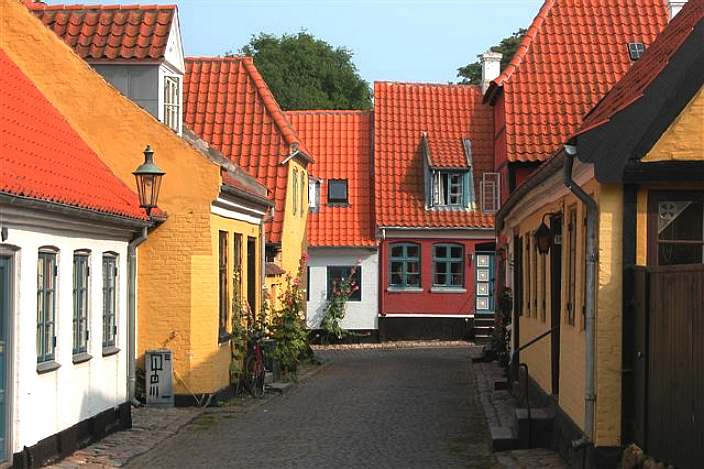
CONSTITUTIONAL MONARCHY
The Danish liberal and national movement gained momentum in the 1830s, and after the European Revolutions of 1848 Denmark peacefully became a constitutional monarchy on 5 June 1849. A two-chamber parliament was established. After the Second War of Schleswig in 1864, Denmark was forced to cede Schleswig and Holstein to Prussia, in a defeat that left deep marks on the Danish national
identity. After these events, Denmark pursued a policy of neutrality in Europe.
Denmark remained neutral during World War I. After the defeat of Germany, the Versailles powers offered to return the region of Schleswig-Holstein to Denmark. Fearing German irredentism, Denmark refused to consider the return of the area without a plebiscite. The two Schleswig Plebiscites took place on 10 February and 14 March, respectively. On 10 July 1920, Northern Schleswig (Sønderjylland) was recovered by Denmark, thereby adding 163,600 inhabitants and 3,984 km². The reunion day (Genforeningsdag) is celebrated every year 15 June on Valdemarsdag.
Denmark signed a 10-year non-aggression pact with Nazi Germany in 1939. Germany's invasion of Denmark on 9 April 1940 – code named Operation Weserübung – met only two hours of military resistance before the Danish government surrendered. Economic co-operation between Germany and Denmark continued until 1943, when the Danish government refused further co-operation and its navy sank most of its ships and sent as many of their officers as they could to Sweden. During the war, the government was helpful towards the Danish Jewish minority, and the Danish resistance performed a rescue operation that managed to get most of them to Sweden and safety shortly before the Germans planned to round up the
Danish Jews. Denmark led many "inside operations" or sabotage against the German facilities. Iceland severed ties to Denmark and became an independent republic in 1944, and in 1948, the Faroe Islands gained home rule.
Constitutional change in 1953 led to a single-chamber parliament elected by proportional representation, female accession to the Danish throne and Greenland becoming an integral part of Denmark. The Social Democrats (Denmark) led a string of coalition governments for most of the second half of the 20th century in a country generally known for its liberal traditions. Poul Schluter then became the first Danish prime minister from the Conservative People's Party (Denmark) in 1982, leading a centre-right coalition until 1993, when he was succeeded by the Social Democrat Poul Nyrup Rasmussen. A new centre-right coalition headed by Anders Fogh Rasmussen came to power in 2001 promising tighter immigration controls. A third successive centre-right leader, Lars Løkke Rasmussen, was prime minister from 2009 to 2011. His government, dependent as it was on the right-wing populist People's Party to push through legislation, witnessed immigration and integration emerge as major issues of public debate. Social Democrat Helle Thorning-Schmidt, Denmark's first female prime minister, took office in 2011, ending a decade of centre-right rule.
After the war, Denmark became one of the founding members of the United Nations and
NATO, and in 1973, along with Britain and Ireland, joined the European Economic Community after a public referendum. The Maastricht treaty involving further European integration was rejected by the Danish people in 1992. It was only accepted after a second referendum in 1993 and the addition of certain opt-out concessions for Denmark. The Danes rejected the euro as the national currency in a referendum in September 2000. Greenland gained home rule in 1979 and was awarded self-determination in 2009. Neither Greenland nor the Faroe Islands are members of the European Union, the Faroese declined membership of the EEC in 1973 and Greenland in 1986, in both cases because of fisheries policies.
Despite its modest size, since World War
II, Denmark has participated in generally UN sanctioned, and often NATO led, military and humanitarian operations, including: Cyprus, Bosnia and Herzegovina, Korea, Egypt, Croatia, Kosovo, Ethiopia, Afghanistan, Iraq, Somalia and recently Libya. In 2009 Anders Fogh Rasmussen resigned as Prime Minister of Denmark to become the Secretary General of
NATO.
LINKS
& REFERENCE
Denmark.dk
Denmark
entry at The World Factbook
Denmark
entry at Encyclopædia Britannica
A
guide to Danish Culture at Denmark.net
Denmark
at UCB Libraries GovPubs
Denmark
at the Open Directory Project
Denmark
profile from the BBC
News
Tourism
portal at VisitDenmark.
Key
Development Forecasts for Denmark from International Futures
Ministry
of Foreign Affairs of Denmark
Chief
of State and Cabinet Members
Summary
vital statistics about Denmark from Statistikbanken
Wikimedia
Atlas of Denmark
Denmark
at OpenStreetMap
Satellite
image of Denmark at the NASA Earth Observatory
Google
news Denmark
History
of Denmark: Primary Documents
Krak
printable mapsearch
Ministry
of the Environment National Survey and Cadastre
Old
Denmark in Cyberspace – Information about Denmark – the Danes
Vifanord.de
– library of scientific information on the Nordic and Baltic countries
http://www.nato.int/
http://188.64.159.37/graphics/Publikationer/Havvindmoeller/hele.htm
|
Adelaide
Aden
- Yemen
Afghanistan
Africa
- Central
- East
Alaska
Algeria
Amsterdam
Antarctic
- Antarctica
Arctic
- North
Pole
Argentina
Asia
Athens
Atlantis
- Plato's Lost City
Australia
Austria
Aztecs
- Mexico
Bahamas
- Crooked
Island
Bangladesh
Baghdad
Bahrain
Barbados
Beachy
Head, England
Belgium
Berlin
Bermuda
Black
Rock Desert,
Nevada
Bohemia
Bolivia
Bonneville,
Utah - History
Brazil
Brighton
- West Pier
British
Columbia
Bulgaria
Burma
California
Canada
Canary
Islands
Cape
Hope
Cape
York - Au
Caribbean
- Central
America
Cayman
Islands
Chichester
Harbour
Chile
China
- Beijing
Columbia
- S. America
Columbo
- Sri Lanka
Corfu
-
Cowes,
Isle of Wight
Croatia
Cuba
Cyprus
Czechoslovakia
Darwin
- Australia
Daytona
Beach -
Florida USA
Denmark
Dubai
Eastbounre
Pier, England
Earthquakes
East
Africa
Egypt
Equador
Equator
Europe
Falkland
Islands
Falmouth,
Cornwall
Fiji
Finland
Florida
France
Galapagos
Islands
Geography
Links
Geography
Records
|
Geography
Resources
Geography
Statistics
Germany
Gibraltar
- Links
Greece
Greenland
Hampshire
Hawaii
Holland
- Volendam
Hollywood,
California, LA
Hong
Kong
Hungary
Hurricanes
Iceland
India
- Mumbai
Indonesia
Links
Iran
Iraq
Ireland
Isle
of Man
Isle
of Wight - The
Needles
Israel
Italy
Jakarta
- Java
Jamaica
Japan
Jordan
Kent,
England -
Sandgate
Kenya
Korea
Republic
of (South)
Kuwait
Kyoto
- Japan
Las
Vegas -
Lebanon
Libya
Life
on Earth
London
- Big
Ben
London
Eye - Madame
Tussauds
London
Houses
Parliament
London
- Buckingham
Palace
London
- Old
Bailey
London
- Overview
London
- The City
London
- Tower Bridge
London
- Trafalgar
Square
Luxembourg
Malaysia
Malta
Maya
Empire -
Central America
Melbourne,
Australia
Mexico
Middle
East
Monaco
Morocco
Mountains
Naples-
Italy
National
Geographic
Nepal
Nertherlands
- Eindhoven
New
York
New
Zealand
Nigeria
North
Africa
Norway
Nova
Scotia
Oceans
and Seas
Oman
Pakistan
Palermo
- Sicily
Palestine
Palma
- Malorca
|
Panama
Canal - Links
Paris
Pendine
Sands -
Carmarthen
Peru
Philippines
Pisa
Planet
Earth
Poland
Port
Moresby - PNG
Port
Said - Egypt
Portugal
Puerto
Rico
Qatar
Quebec
Rio
de Janeiro
Romania
Rome
Russia
Salt
Lake City -
Utah
Samoa
Saudi
Arabia
Scotland
Senegal
West Africa
Singapore
Somalia
South
Africa
South
America
Southampton
Spain
- Espana
Sri
Lanka - Links
Stonehenge
Suez
Canal
Sudan
Surrey,
England Index
Sussex,
England Index
Sweden
Switzerland
Sydney,
Australia
Syria
Tahiti
- Polynesia - Links
Taiwan
Thailand
Tokyo,
Japan
Tonga
- Polynesia
Toronto
Trinidad
- Lesser Antilles
Tsunami
Tunbridge
Wells, England
Tunisia
Turkey
UAE
- United Arab Emirates
UK
Statistics
Ukraine
United
Kingdom
United
Kingdom -
Gov
Uruguay
- South America
USA
Vatican
City
Venezuela
Venice
Vienna
Vietnam
Volcanoes
Wales
- Bridgend
Washington
D.C.
Wealden
iron industry
Wendover,
Utah
West
Africa
World
Peace Supporters
Yemen
Yugoslavia
Zurich
|
Solar
Cola drinkers care about planet
earth
..
Thirst for Life

(330ml
Planet Earth can)
|















